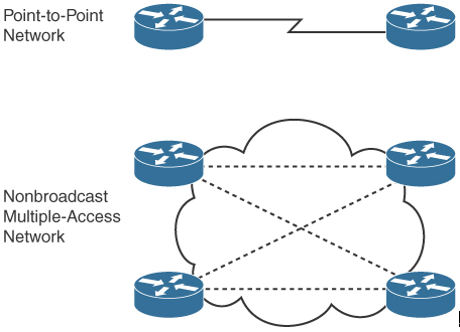OSPFv2 Adjacencies and Hello Timers – OSPF, BGP, and Route Manipulation
OSPF uses Hello packets for neighbor discovery. The default Hello interval is 10 seconds (30 seconds for nonbroadcast multiaccess [NBMA] networks). For point-to-point networks, the Hello interval is 10 seconds. Hellos are multicast to 224.0.0.5 (ALLSPFRouters). Hello packets include information such as the router ID, area ID, authentication, and router priority.
After two routers exchange Hello packets and set two-way communication, they establish adjacencies. To become OSPF neighbors, the following values must match:
- Area ID
- Authentication password
- Hello and Dead Intervals
- Stub flag
- MTU size
OSPF Message Types
OSPF uses five different message types to exchange information between routers:
- Type 1: Hello packets: This message type is used to discover and maintain neighbor relationships.
- Type 2: Database Description (DBD) packets: This message type is used to summarize database information and ensure that the databases are in sync.
- Type 3: Link-State Request (LSR) packets: This message type is used for database downloads. It is sent to OSPF neighbors to request the most recent version of missing LSRs.
- Type 4: Link-State Update (LSU) packets: This message type is used to update the database. LSU packets are used for the flooding of LSAs and for sending LSA responses to LSR packets.
- Type 5: Link-State Acknowledgement (LSAck) packets: This message type is used to acknowledge the flooding of LSAs. Multiple LSAs can be acknowledged in a single LSAck packet.
DBD and LSR packets are used for database synchronization after adjacencies are formed between OSPF routers.
Figure 4-1 shows a point-to-point network and an NBMA network. For point-to-point networks, valid neighbors always become adjacent and communicate using multicast address 224.0.0.5. For broadcast (Ethernet) and NBMA networks (Frame Relay), all routers become adjacent to the designated router (DR) and backup designated router (BDR) but not to each other. All routers reply to the DR and BDR using the multicast address 224.0.0.6. The section “OSPF DRs,” later in this chapter, covers the DR concept.

Figure 4-1 OSPF Networks
On OSPF point-to-multipoint nonbroadcast networks, it is necessary to configure the set of neighbors that are directly reachable over the point-to-multipoint network. Each neighbor is identified by its IP address on the point-to-multipoint network. Nonbroadcast point-to-multipoint networks do not elect DRs, so the DR eligibility of configured neighbors is undefined. OSPF communication in point-to-point networks uses unicast or multicast addresses for neighbor communication.
OSPF virtual links send unicast OSPF packets. Later in this chapter, the section “Virtual Links” discusses virtual links.
